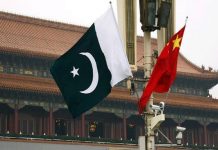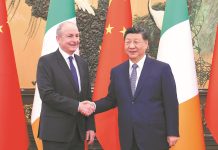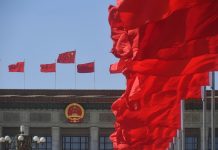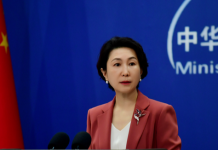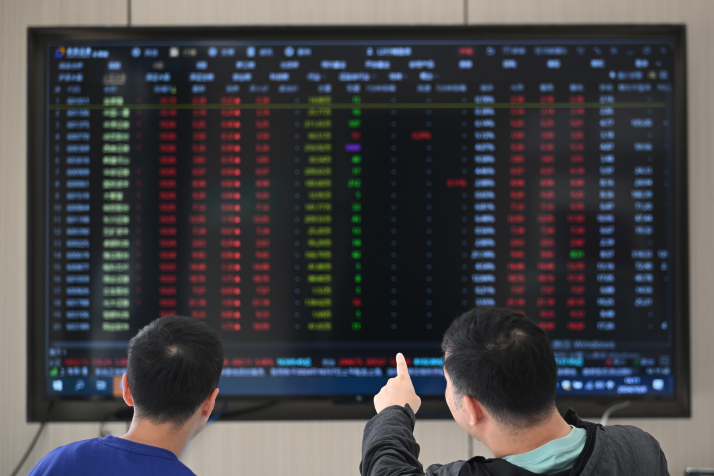
Chinese securities brokerage firms were busier than usual during the recently concluded National Day holiday (October 1-7). Upon receiving numerous requests to open new accounts or reset passwords for dormant accounts, they provided round-the-clock online services for account opening and consulting during the holiday.
This investor enthusiasm was ignited by a strong rebound in China’s stock market right before the holiday. Fueled by a series of stimulus measures announced on September 24, the benchmark Shanghai Composite Index, an index of all stocks traded on the Shanghai exchange, gained more than 15 percent from September 26 to 30, while the Shenzhen Component Index, a main index of the Shenzhen exchange, rose by more than 23 percent. The combined trading value at the Shanghai and Shenzhen exchanges hit a new single-day record of 2.6 trillion yuan ($370 billion) on September 30. The market rally continued after the holiday, with the combined turnover of the Shanghai and Shenzhen bourses reaching 2.48 trillion yuan ($350 billion) on October 8.
The upbeat sentiment about Chinese stocks was also felt abroad. The Nasdaq Golden Dragon index of U.S.-listed Chinese stocks rallied 11 percent during the New York session on September 26, the biggest jump in more than two and a half years.
The investment narrative about China has also changed. Roughly one month ago, the ABC acronym stood for “All But China.” But it has recently shifted from this pessimistic attitude to the more optimistic “All-in, Buy China.” In an interview with U.S. business news channel CNBC on September 26, U.S. billionaire investor David Tepper said it’s a “buy everything” moment for Chinese stocks.
JP Morgan’s Asia Investment Strategy team wrote in an online report on October 1 that they are increasing their Chinese equity price outlooks and “shifting the strategic view from negative to neutral.”
Goldman Sachs has upgraded its outlook for Chinese stocks to “overweight.” Its strategists wrote in a note on the company’s official website on October 5 that Chinese equities may rise a further 15 to 20 percent.

Policy incentives
All this change is driven by a more massive-than-expected policy package announced by China’s central bank, top securities regulator and financial regulator at a joint press conference on September 24. The package includes a series of monetary stimulus efforts, property market support and capital market strengthening measures. These initiatives have reignited investor enthusiasm and bolstered market confidence in China’s economic recovery and high-quality development.
In terms of monetary stimulus, the People’s Bank of China (PBC), the country’s central bank, cut the reserve requirement ratio (RRR), or the portion of deposits that banks are required to keep in reserve and not lend out, by 0.5 percentage points on September 27, following central bank governor Pan Gongsheng’s announcement at the conference.
With the central bank’s RRR cut, commercial banks are allowed to hold fewer reserves, freeing up some 1 trillion yuan ($142 billion) of long-term liquidity to inject into the financial market.
To stabilize and revitalize the real estate sector, the PBC and the National Financial Regulatory Administration rolled out a wave of policies on September 29, as follow-up action of the conference.
The mortgage rates for first homes, second homes and more are required to be reduced no lower than 0.3 percentage points below the loan prime rate by October 31, 2024, to ease financial burdens on property owners. The minimum down payment ratio for individuals’ commercial housing mortgages will be lowered to no less than 15 percent for both first-home and second-home purchases. The pricing mechanism for interest rates of individuals’ commercial housing mortgages will be refined so that the rates can be adjusted dynamically based on agreements between borrowers and banks.
The central bank will increase funding for financial institutions if they issue loans to support local state-owned enterprises to acquire completed yet unsold commercial housing at reasonable prices for use as affordable housing.
According to Pan at the conference, the new policies intend to further reduce borrowers’ interest expenses, potentially benefiting 50 million households, or about 150 million people. The move is estimated to reduce total household interest expenses by approximately 150 billion yuan ($21 billion) per year on average, helping to boost consumption and investment.
In support of the financial market, the central bank will introduce new monetary policy tools to ensure the stable development of the domestic stock markets. This includes establishing a swap program that allows securities, funds and insurance companies to access liquidity from the central bank through asset collateralization. Pan noted that this initiative will enhance these companies’ ability to secure funds and increase their stock holdings.
The central bank announced on October 10 that it had decided to set up the Securities, Funds and Insurance Companies Swap Facility, with an initial scale of 500 billion yuan ($71 billion).
Managing expectations
“China’s recent actions align with the correct logic of macro-policy expectation management, a key reason for the recent market surge,” Tian Xuan, Associate Dean and chair professor of finance at Tsinghua University’s PBC School of Finance, told Beijing Review.
Tian added that even minor changes in monetary policy can influence public expectations about the future, affecting their production, investment and consumption behaviors, which may, in turn, lead to economic fluctuations. “This means that economic actors respond not only to current policies but also anticipate future ones,” he explained.
The power of expectation management is becoming a new favorite in macroeconomic regulation. This theory underscores that policymakers must focus on how their actions shape public expectations, as these ultimately determine the direction of the economy, Tian continued.
“The goal of policy actions should be to stay ahead of market expectations. Responding only after pessimistic expectations have formed often leads to inefficiencies. In extraordinary times, the release of extraordinary policies should be bold, focusing on ‘outperforming expectations’ and ‘preemptive measures’ in managing policy expectations,” Tian remarked.
Two days after the press conference on financial measures, the Political Bureau of the Communist Party of China (CPC) Central Committee held a meeting on September 26 to analyze the current economic situation and outline further actions.
The meeting stressed the importance of effectively implementing existing policies, accelerating new policy measures and making them more targeted and effective, aiming to achieve the economic and social development goals set for this year.
Liu Ying, Director of the Cooperative Research Department at the Chongyang Institute for Financial Studies at Renmin University of China, told Beijing Review: “The policies span the monetary, fiscal and industrial sectors. Effective implementation is key.”
Liu further underlined that, as a major manufacturing country, China should accelerate the development of emerging and future industries, such as the low-altitude economy and quantum information, and foster new quality productive forces. The concept of “new quality productive forces” refers to China’s shift toward innovation-driven growth, technological advancement and high-quality development in different sectors of the economy. “We need to consider what our economic growth points are and then seize, develop and enhance them for faster growth,” she added.

Remain confident
As Zheng Shanjie, Chairman of the National Development and Reform Commission (NDRC) pointed out at a press conference on October 8, China’s economy is facing
difficulties.
The external environment is becoming increasingly complex and severe. International markets are facing volatility, global trade protectionism is on the rise and uncertain and unstable factors are increasing, all of which may negatively affect China through trade, investment and financial channels.
According to the latest forecast from the International Monetary Fund, global economic growth is projected to be 3.2 percent this year, a decline from last year. Major economies are experiencing weak growth momentum and heavy debt burdens, with many recently implementing interest rate cuts.
Domestically, China’s economy is also under growing downward pressure. Since July, major economic indicators, including industrial production, investment and consumption, have fluctuated. Some industries are looking at heightened competition, while others are struggling to adapt to the changes brought about by optimization and transformation. Additionally, some enterprises are increasing production without corresponding gains in revenue or profit, and certain sectors are experiencing operational difficulties, with considerable risks lingering in some areas.
The September 26 meeting held by the CPC Central Committee Political Bureau underlined the importance of taking a comprehensive, objective and clear-eyed view of the current economic situation, facing the difficulties squarely, and remaining confident.
“Remain confident” is the overarching theme for China’s economic strategy, as also conveyed in two previous meetings held by the bureau this year.
The bureau’s April 30 meeting stated that China’s economy still has a solid foundation, plenty of advantages, strong resilience and huge potential. It called for efforts to strengthen confidence in economic activities.
The July 30 meeting saw a focus on raising awareness of risks, preparing for worst-case scenarios and maintaining strategic resolve and confidence in the country’s development.
The strength to “remain confident” is supported by the stable trend of China’s economic performance. The fundamentals of the Chinese economy remain unchanged, with favorable conditions such as a vast market, strong economic resilience and great potential, Zheng said at the press conference.
Bolstered by existing and newly introduced policies, market sentiment has improved, including a rise in the Purchasing Managers’ Index, an economic indicator that gauges activity in the manufacturing and services sectors, a warming stock market and robust consumption during the National Day holiday, Zheng added.
According to Zheng, a raft of reform measures conducive to economic development will be rolled out, which include the formation of guidelines on building a unified national market, a new negative list for market access and mechanisms to ensure increased investment in future industries. A negative list refers to a list of sectors or industries in which foreign investment is restricted, prohibited, or subject to specific conditions. China will expand the catalogue of industries that encourage foreign investment, unveil a new group of major foreign-invested projects and make its visa-free transit policies more open.
With the gradual impact of newly introduced policies, China’s economic vitality will be further unleashed, market confidence will grow stronger and the foundation for high-quality development and stable economic performance will be further consolidated, Zhao Chenxin, Vice Chairman of the NDRC, said at the October 8 press conference.
China is confident in maintaining steady economic growth and achieving its full-year growth target of roughly 5 percent, Zheng told the press conference. –The Daily Mail-Beijing Review news exchange item

